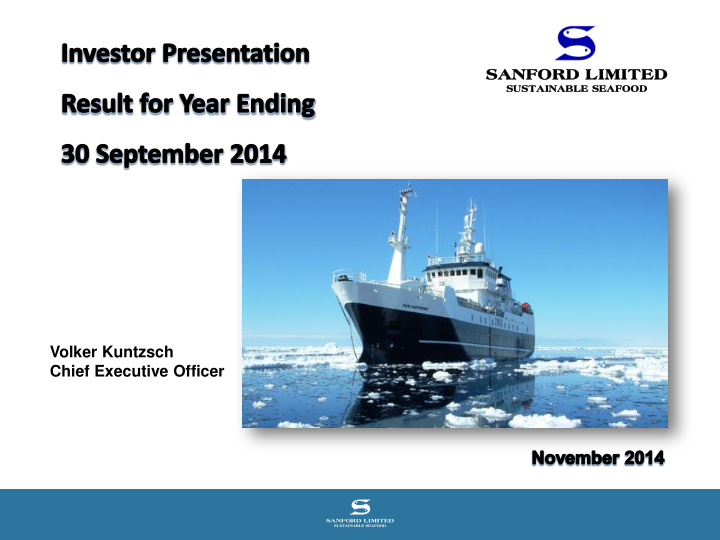



SANFORD L LIMITED SUSTAINABLE SEAFO FOOD Volker Kuntzsch Chief Executive Officer
Disclaimer This presentation contains not only a review of operations, but also some forward looking statements about Sanford Limited and the environment in which the company operates. Because these statements are forward looking, Sanford Limited’s actual results could differ materially. Media releases, management commentary and analysts presentations, including those relating to the previous results announcement, are all available on the company’s website and contain additional information about matters which could cause Sanford Limited’s performance to differ from any forward looking statements in this presentation. Please read this presentation in the wider context of material previously published by Sanford Limited. 2
2014 Review 3
Year End Result 2014 4
2014 In Review • Highlights – 10% improvement in PAT from 2013 – Acquisition of GNZ – New organisation structure implemented – Mussel pricing and harvest volume – aquaculture – Final dividend maintained at 14 cents per share and fully imputed – payable 10 December 2014. • Lowlights – Challenging skipjack tuna market and fishing environment – Insurance events – Pelagic species: challenges in demand 5
2013 – 2014 EBITDA Bridge • Fishing – weak demand and a sharp decline in pelagic prices led to a significant downward shift in earnings. One less charter vessel than prior year plus the sale of a purse seiner in Q3 impacted catch rates. • Aquaculture Mussels – improved mussel prices and increase in stock in water fair value • Aquaculture Salmon – increased fresh fish sales into the NZ market
Global Outlook 7
Global Fisheries Production Capture and Aquaculture Million MT 157 158 122 126 125 128 127 134 136 137 141 143 146 148 120 120 114 Source: FAO Fishery Statistics 8
Global Fisheries Production Share of Capture and Aquaculture Million MT 157 158 122 126 125 128 127 134 136 137 141 143 146 148 120 120 114 Source: FAO Fishery Statistics 9
Global Groundfish Summary Major Species (Cod, Haddock, Hake, Hoki, Pollock etc.) Million MT Source: until 2012 = FAO; 13 - 15 = PANELISTS / OWN ESTIMATES Courtesy: Groundfish Forum 10
World Aquaculture 1994 - 2012 By Category (including Seaweed) Million MT 90 90 83 83 72 77 77 68 72 68 64 64 61 61 54 57 57 54 49 51 51 46 49 44 46 42 44 39 42 36 39 34 36 31 34 28 31 28 Source: FAO Fishery Statistics 11
Demand for seafood to come from emerging economies Asia – Pacific stands out as the region that holds the greatest potential for increases in seafood consumption and an appreciation for quality and provenance
Seafood holds great potential • Only 45% of NZer’s eat fish once a week, local market too small compared to other islands • Over 80% of our product is exported. Key destinations are Australia, North America, Europe, Korea, China and Japan • Global seafood consumption is increasing • Key drivers for increased consumption are growing health consciousness, affluence, aging populations
Sanford Looking Forward 14
From a Strong History… • Owns ¼ of New Zealand’s fishing quota • Farms a large share of New Zealand's Greenshell mussels and King salmon • Mainly a commodity producer - Sanford’s customers are wholesalers, traders and processors • 100+ years on NZX Mr and Mrs Albert Sanford established Sanford in 1881 and we’ve fished for snapper in the Hauraki Gulf ever since.
Diversified Species Portfolio 16
Diversified Markets 17
VISION • To be the Best Seafood Company in the World MISSION • Make Sanford the NZ Company of Choice – Sustainably provide innovative, quality seafood and marine products – Delivering value to consumers, customers, employees and shareholders – Social licence to operate 18
Strategic Pillars • Consistently High Quality Products – PSH – Operations Excellence – Quality Control – Fresh is Best – Provenance • Culture of Innovation and Customer Service – R & D Investment – Supply Chain Management – Beyond Commodity – Understand Consumer needs Scope – Develop relevant brand • Market Development – Australia – New Zealand – Asia • Value Optimisation – Operational Excellence - Lowest Cost, Efficient – Supply Chain Excellence – Best value use of scarce resource 19
Enablers • People – Right Structure – Right People – Engagement – Performance Management • Process – Internal Alignment – Supply Chain Process – S&OP – Internal Decision Making Process – Strategic Planning and Budgeting • Systems – Stabilise and Fix Foundations – Decision Support Systems • Right Information on Timely Basis – Automation and Simplification 20
Focus on 2015 • TACC increase in hoki and orange roughy, two key deep water species from 1 October 2014 • Strong global demand will support firm prices • Skipjack tuna and blue mackerel pricing will remain under pressure • Improved exchange rate positions from 2014 and well hedged forward • Embed new organisation structure • Introduce new disciplines of Supply Chain Management and Procurement • Enhance our Brand • Channel and market development
New Structure to Focus the Business CEO Group Quality Group Sales CFO COO CPO GM Innovation GM Brands Manager Manager Finance Processing Human Resource Compliance New Products New Branding Customer Relationship Treasury Supply Chain Sustainability Quality New Processes Site Development Sales IT Fishing Retention Enhancement Australian Market Auckland Fish New Channels Payroll Farming Culture Market New Markets Legal Procurement Investor Relations • Functional structure provides focus and consistency across the business • Simplification of process with clear accountabilities • New disciplines of Supply Chain Management and Procurement introduced
Sanford is moving beyond commodity • Conserving freshness brings the highest value • New harvesting technology • Finding our ‘New Zealand’ point of difference • Creating high value products for niche markets • We believe our customers will pay for quality, provenance, sustainability, service
Q&A
Recommend
More recommend